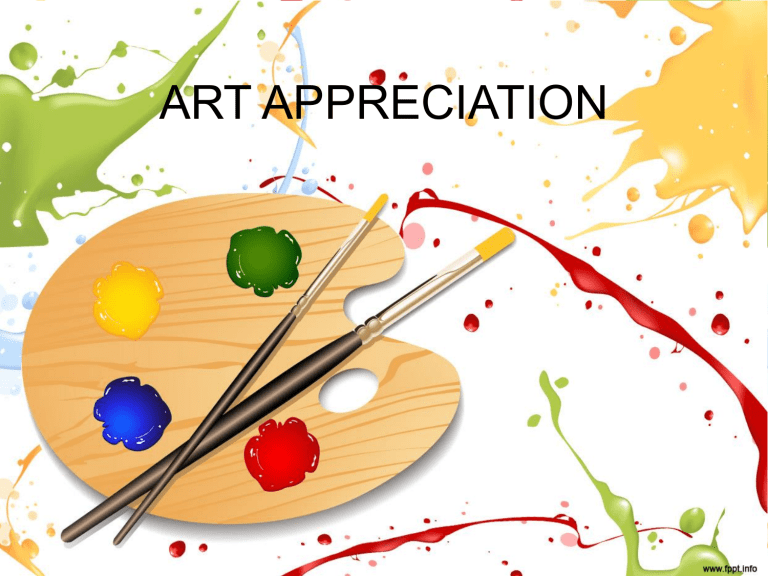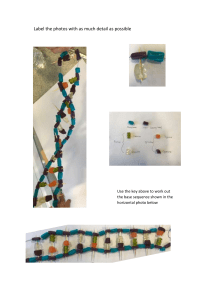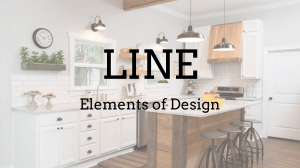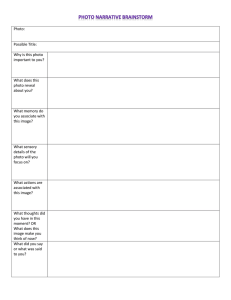
ART APPRECIATION The Elements of Visual Arts The Elements of Visual Arts LINE • Line is a mark on a surface that describes a shape or outline. It can create texture and can be thick and thin. Types of line can include actual, implied, vertical, horizontal, diagonal and contour line. LINE • is an important element at the disposal of every artist. • always has direction, always moving. • as used in any work of art, may either be straight or curved. • Lines are the first element of art and are continuous marks that are made on any surface with a moving point. • Lines can be used in various ways to create different compositions. • A line can be used to express various things or feelings; it can be used to show various moods or anything abstract. Line serves as an essential building block of art, but it can also serve as the content itself of a work of art, or be manipulated to evoke an emotional or intellectual response from a viewer (Fichner-Rathus, 2010). What do these lines suggest? VERTICAL LINES HORIZONTAL LINES DIAGONAL LINES CURVED LINES Vertical Lines • Vertical lines are poised for action. They are poised, balanced, forceful, and dynamic. They express an impression of dignity. Only vertical lines can be used to express an orderly feeling VERTICAL LINES Horizontal Lines • Horizontal lines are lines of repose and serenity. They express ideas of calmness and quiescence.. Only horizontal lines can give a feeling of peacefulness and stillness. BORACAY Travel News Philippines: Discovery Shores Boracay gets three awards from Travel + Leisure, Siargao Named 9th best Surfing Spot Worldwide by CNN SIARGAO Diagonal lines are used to create feelings of movement or action. SIARGAO: The Surfing Capital of the Philippines Curved lines, sometimes referred as S curves, suggest gracefulness or sexiness. If you want to photograph S curves, the human body makes for a wonderful subject. From the arch of a foot to the curve of a neck, you can find many ways to capture curved leading lines by photographing the human form. It is up to the artist how he conveys his message, in the best way possible through the use of lines. There are various ways to integrate lines into a photograph to help strengthen the overall composition and draw attention to a specific focal point. ACTIVITY: LEADING LINES IN PHOTOGRAPHY When using vertical lines within a photo, it’s a good idea to follow the rule of thirds, failure to do so can result in a photo looking as though it’s been cut in half. It is also important to try to keep the vertical line as straight as possible. Vertical leading lines can help to illustrate growth, authority, strength, or dominance. Some examples of vertical leading lines in photography include photographs of trees or tall buildings. When composing your photo to include horizontal leading lines, make sure they’re as straight as possible and consider following the rule of thirds. This photo, for example, places the land and horizon along the bottom third of the image, while the sky fills the top two-thirds of the shot. Further, the photo was composed so the bride and groom are along the left-third of the image. This photo uses both horizontal and vertical lines. Although the bulrushes are the obvious use of vertical lines, the horizontal line of the horizon is more subtle. Note, too, that the photo has been composed so the landscape follows the rule of thirds. Curved lines, sometimes referred as S curves, can help lead the eye through a photo and can suggest gracefulness, sexiness, or sensuality. Despite the name, S curves don’t need to be shaped exactly like an “s.” Any strong leading line that winds or curves can be considered an S curve. Some curved leading lines often used in photography include paths and rivers. When including diagonal leading lines within a photo, it’s best if you can position them so that they start and finish just above or below the corner of a photo, like the railroad tracks shown here. This will prevent the image from looking like it has been split in half. Because our eyes naturally scan photos from left to right, composing an image to include diagonal leading lines that flow from the bottom left to the top right of a photo is also a great way to compose a shot. The body of this acoustic guitar is a great example of S curves. Note the use of other leading lines in this photo too – the diagonal lines of the guitar strings, and the horizontal lines of the sheet of music in the background. Three Main Types of Lines • Repetition occurs when two or more lines are drawn within a corner following the lines of the corner. Three Main Types of Lines • Lines that are in opposition to each other form a contrast. Three Main Types of Lines • A transition line is a line that connects two workflow elements. Transition lines allow you to define what the next step in a workflow will be. To summarize, including leading lines within a photograph is a composition technique that can strongly influence the overall result of an image. Leading lines can direct a person’s eye to a main focal point or, if used incorrectly, can draw the eye away from the subject or appear to cut a photo in half. The Art Element of Color Color refers to the visual perception of light being reflected from a surface of an artwork. In the most basic classification, colors can be divided into three groups: primary, secondary and tertiary. Attributes of Color • Hue is the term for the pure spectrum colors commonly referred to by the "color names" - red, orange, yellow, blue, green violet which appear in the hue circle or rainbow. Theoretically all hues can be mixed from three basic hues, known as primaries. Color Wheel • A color wheel is an abstract illustrative organization of color hues around a circle, that shows relationships between primary, secondary, and tertiary colors, etc. Attributes of Color • Value refers to the lightness or darkness of a color. It is the quality which depends on the amount of light and dark in color. Attributes of Color • Tints are values above the normal • Shades are values below the normal. Intensity refers to the brightness or darkness of color. It gives color strength. When a hue is vivid form, it is said to be in full intensity. When it is dulled, it is said to be partly neutralized. Psychology of Colors • Colors have varied psychological and emotional connotations. – – – – Black is associated with death and gloom White stands for purity and innocence Red is associated with blood, anger and fear Green implies happiness and abundance Meanings of Colors Conveyed by the Rose •Red is for “I love you” •Pink conveys “Thank you” •White says “You are heavenly” •Coral speaks of desire. •White roses denote secrecy, reverence and humility. •Deep pink roses convey gratitude and appreciation. •Light pink express sympathy, grace and gentility • Red roses also mean courage and fortitude • Yellow roses stand for freedom • Red and Yellow stand for jovial /happy feelings • Orange roses speak of enthusiasm and desire • Red and White convey unity TEXTURE is the element that deals more directly with the sense of touch. applies to how an object feels or appears to feel. can be either implied or actual. texture • Texture is the element that deals more directly with the sense of touch. • It has to do with the characteristics of surfaces which can be rough or smooth, fine or coarse, shiny or dull, plain or irregular. • Implied texture expresses the idea of how a surface might feel. For example, a painting of a blanket might convey the idea that the blanket is soft. • Actual texture, on the other hand, is texture that can actually be felt. For example, a ceramic bowl might feature a carved texture that could be felt when holding that bowl. WOOD TEXTURE PERSPECTIVE • Perspective deals with the effect of distance upon the appearance of objects, by means of which the eye judges spatial relationships. Kinds of Perspective • Linear perspective is the representation of an appearance of distance by means of converging lines. • It has to do with the direction of lines and with the size of objects. Linear Perspective •Painters usually show the effect of space and distance by using converging lines and diminishing size. •Parallel lines below the eye level seem to rise to a vanishing point in the horizon, while those above the eye level seem to descend to the vanishing point. Foreshortening is the representation of objects or parts of the body as smaller from the point of view of the observer. Kinds of Perspective • Aerial perspective is the representation of relative distances of objects by gradations of tone or color. • Objects become fainter in the distance due to the effect of the atmosphere. Objects appear to be lighter in color as they recede into the distance or atmosphere. The Art Element of Space Space refers to how the artist fills the surface on which a work of art is created. It can also refer to the expression of depth within a work of art. When talking about a three-dimensional object, space is the actual volume that is taken up by the artwork. SPACE • Space as an element of art, refers to distances or areas around, between or within components of a piece. • Space can be positive (white or light) or negative (black or dark),open or closed, shallow or deep and twodimensional or threedimensional. • Sometimes space isn't actually within a piece, but the illusion of it is. Kinds of Space • Positive space - the areas in a work of art that are the subjects, or areas of interest. • Negative space – areas around the subjects, or areas of interest. Shape, Form, and Volume are words that are used to describe distinct areas or parts of works of art or architecture. FORM • Form applies to the over-all design of a work of art. • It describes the structure or shape of an object. The Art Element of Form Form refers to a three-dimensional object. As such, form is an art term that is only applied to those artworks that are three-dimensional, such as sculpture and pottery. Forms, much like shapes, can be geometric or organic. Geometric forms have hard lines and edges. Organic forms are curvy and more free-form. Types of Form • Form and shape can also be described as either organic or geometric. • Organic forms such as these snow-covered boulders typically are irregular in outline, and often asymmetrical. Organic forms are most often thought of as naturally occurring. • Geometric forms are those which correspond to named regular shapes, such as squares, rectangles, circles, cubes, spheres, cones, and other regular forms. Organic and Geometric Forms KENNETH COBONPUE’S DESIGNS Kenneth Cobonpue 's Knottee hanging lamp at Hive Croissant sofa Croissant Amaya CoffeeTable Yin Yang Chair VOLUME • Volume refers to the amount of space occupied in three dimensions. • It refers to solidity or thickness. References: Callow, R. (2014, January 21). Photo Gallery: Leading Lines in Photography. Retrieved from http://blog.posterjack.ca/2014/01/21/ photo-gallery-leading-lines-in-photography/ Fichner-Rathus, L. (2010). Foundations of Art and Design. USA: Thomson Learning Inc. Rich, S. (2005, September 9). Kenneth Cobonpue. Design, Green Furniture. Retrieved from http://inhabitat.com/kenneth-cobonpue/




